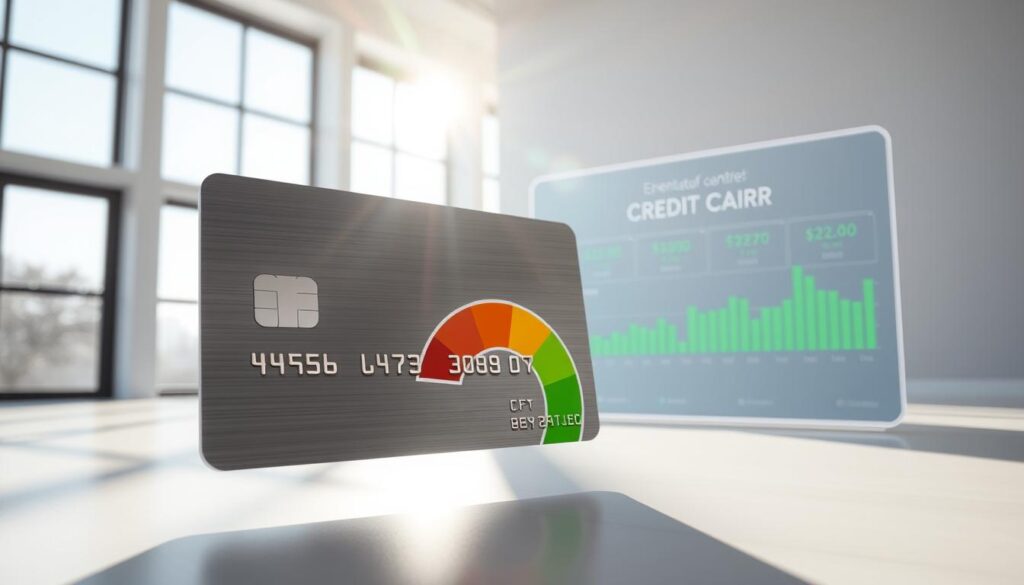Anúncios
Improving your credit score can help in more ways than just getting good loan deals. In the U.S., FICO and VantageScore are key scoring systems. They range from poor to excellent. Knowing these ranges helps you understand how to boost your overall credit health.
Anúncios
Studies have shown that having financial stability means you’re less stressed. People with better credit can easily get preventive care, afford medicine, and handle long-term health issues. Less money worries mean better sleep, mood, and energy. These are all key for your financial wellbeing.
Here, we give you easy-to-follow steps aimed at Americans to improve your credit score. You’ll learn about budgeting, managing debt, making payments on time, keeping credit use low, and how to keep track of progress. We also talk about community help. Each tip links how fixing your credit can actually make your life better.
Anúncios
Key Takeaways
- Credit scores (FICO, VantageScore) frame what “improvement” means and influence financial options.
- Better credit health often reduces stress and improves access to healthcare.
- Small credit improvements can support broader financial wellbeing and daily habits.
- The article will cover budgeting, debt strategies, payment habits, and tracking tools.
- Practical steps to raise credit score are tied to measurable health and quality-of-life gains.
How financial health and physical health are connected
Money matters and health are deeply linked. Worrying about finances can mess with your hormones, disrupt your sleep, and make your blood pressure go up. These changes show how financial stress impacts your health in real life.
Stress, money worries, and physical wellbeing
Money stress and health issues often appear together. Studies from the CDC and the American Psychological Association show that financial stress can increase feelings of anxiety and depression. This kind of long-term stress can also raise cortisol levels, hurting your immune system and metabolism.
Having trouble sleeping because of money worries can lead to bad choices, like eating too much or not exercising. And unexpected medical bills can trap families in a cycle where health and financial problems make each other worse.
Access to healthcare and preventive services
Having a stable financial situation can make it easier to get healthcare and preventive services. If you have good credit and a regular income, you’ll find it easier to get health insurance, go to lower-cost clinics, and pay for necessary treatments. Your credit score can even influence whether you get approved for medical loans and their interest rates.
Programs like Medicaid and the ACA are there for low-income Americans, but financial stability brings more options. Being able to afford preventive care means getting regular check-ups that can find health problems early, which saves money in the long run.
Healthy habits supported by financial stability
When you have a reliable income and your debts are under control, making healthy choices becomes easier. Families with stable finances can afford good food, gym memberships, therapy, and regular doctor visits. These choices promote long-term health.
Studies in behavioral economics suggest that less financial stress improves your ability to make good decisions. When you stop worrying about money, choosing healthy foods, getting enough sleep, and exercising becomes easier. This shows how managing your money well can also lead to better health outcomes.
Understanding credit basics for overall wellness
Good financial health leads to peace of mind. Knowing about credit helps you stress less and grab better chances in life. Small changes in habits can greatly improve your day-to-day and future plans.
What a credit score measures and why it matters
A credit score shows if you pay back money on time. It looks at payment history, how much you owe, how long you’ve had credit, any new credit, and the types of credit you use. Payment history is very important. Paying on time is better than many other strategies.
Your credit use ratio is how much of your credit you’re using. A lower ratio is good for your score. A long credit history shows lenders you’re reliable. Too many new accounts can drop your score for a bit.
Credit scores help set your loan interests and whether you get approved. A better score can get you lower rates on big loans. This means less monthly spending and more for things like health and savings.
Common myths about credit
Myth: checking your credit score hurts it. Truth: When you check your score, it doesn’t go down. Experian, TransUnion, and Equifax say it’s okay to check for yourself.
Myth: having a small balance boosts your score. Truth: It’s better to pay off what you owe and keep a low balance. The system prefers if you owe little compared to your limits.
Myth: closing old accounts is good for your score. Truth: Ending old accounts can shorten your credit history and bump up your credit use ratio, lowering your score. FICO and VantageScore advise to be careful with old accounts.
How credit decisions influence life opportunities
Credit choices affect more than just loans. High interest rates mean you pay more each month. This could mean less money for food, working out, or healthcare.
Renters with low credit might not get apartments or might have to pay more upfront. Small-business loans and even some jobs look at your credit. These things affect your career and how much you make.
Credit problems can lead to more stress, poor sleep, and anxiety. Knowing how credit works lets you focus on keeping both your finances and health in a good place.
credit score improvement
Improving your credit score is good for your wallet and your stress levels. Here are steps, timelines, and tools that make credit better quickly. These include smart tips for fixing credit and dependable apps for tracking how well you’re doing.

Key actions that directly improve your score
Always pay on time. Your payment history is a big part of your credit score. So, remember to pay or set up autopay with companies like Chase, Bank of America, or Discover.
Lower your credit use. Try to use less than 30% of your credit, even less than 10% if you can. If needed, make several small payments during the month to reduce your balance.
Think twice before opening new accounts. Each new account could lower your score a little. Get a new card only if it really helps you, like one with no interest at the start for transferring balances.
If you find mistakes on your credit report, tell Equifax, Experian, and TransUnion. Collect proof, submit your complaint online, and keep checking until they fix it.
Add good credit lines if it makes sense. If you become an authorized user on a relative’s old card or get a loan designed to build credit from a community credit union, it can show a good credit history.
Timeline for seeing credit score changes
Fixing your payment history usually shows up in 30–90 days. Quick payments now might show after your next statement.
Lowering what you owe can be seen quickly, often in one or two billing cycles, if you significantly reduce how much credit you use.
When you challenge mistakes, credit bureaus often take 30–45 days to investigate. If they agree there’s a mistake, they have to fix your record and your score should get better.
Recovering from missed payments or debts sent to collection agencies takes time, months or even years. Big negative marks lessen with time, yet paying on time consistently helps recover faster.
Tools and apps to monitor progress
Credit Karma gives free updates from TransUnion and Equifax. Experian’s app gives a free score similar to FICO and alerts you to any changes.
MyFICO offers more detailed FICO scores and tools for planning how to boost your credit quickly, but it’s not free.
Budget apps like Mint and YNAB help you spend wisely and avoid late payments. Credit Sesame offers free updates and identity theft alerts for extra safety.
Turn on alerts from your credit cards and banks to keep track of bills and unusual spending. Pair these alerts with credit tracking apps for the best view of your progress.
Budgeting strategies that reduce stress and boost credit
Creating a good budget can make you less anxious and help your credit score. Start by tracking every dollar you spend for a month. Then, pick a budgeting method that suits you best.
Creating a realistic monthly budget
Consider trying the 50/30/20 rule or a zero-based budget to align spending with your goals. With the 50/30/20 approach, half your income is for needs, 30% for wants, and 20% for savings and debt. Zero-based budgeting gives every dollar a role, leaving no money unused.
First, make sure you cover basic needs, then plan for regular debt payments and saving goals. Use bank statements or budget apps like Mint or YNAB to monitor your money for a month. Cut back on extra spending to have more for improving your credit score.
Emergency funds and their role in preventing debt
Having a little saved can prevent big troubles. Start with a small goal of $500–$1,000, then work up to 3–6 months of expenses. This helps you stay away from high-interest loans for unexpected bills.
Put your savings where you can get to them easily, like in a high-yield account or money market fund. Build your fund with automatic transfers or extra earnings. Knowing why emergency funds are key can help you keep up payments and safeguard your credit.
Automating payments to avoid late fees
Using auto-pay for credit cards and bills can help you avoid late payments. Sign up through your bank or card provider to pay minimums or the full amount. Also, choose dates to check your account regularly to avoid fees.
If auto-pay isn’t an option, reminders or bill-paying services can keep you punctual. Mixing automation with regular checks will ease your mind and ensure a good payment history.
Smart debt management for mental and financial relief
Good debt management can lessen stress and free up cash for health and daily living. Follow simple steps to sort out your debts, think over debt consolidation, and get help from credit advisors if necessary. A solid strategy keeps your credit score safe while making you feel more at ease.
When to prioritize debt
Use the avalanche or snowball method to tackle debt. The avalanche method pays off high-interest debts first, saving you money. The snowball method starts with the smallest debts to boost morale and motivation.
If you have a $5,000 balance at 18% interest and a $1,000 one at 10%, paying off the 18% first cuts interest costs. Clearing the $1,000 debt first can give a sense of achievement and motivate you to continue.
Debt consolidation options and pros/cons
Before making a choice, consider these options.
| Option | Pros | Cons | Credit impact |
|---|---|---|---|
| Personal loan | Fixed payments, predictable payoff, may lower rate | Origination fees, needs good credit for best rates | Can improve utilization; new inquiry may cause small dip |
| Balance-transfer card | 0% intro APR promotions, fast interest savings | Transfer fees, high rate after promo ends | New account can change utilization; timely payments matter |
| Home equity loan / HELOC | Lower rates, longer terms | Home is collateral, risk of foreclosure if missed | Large new loan alters credit mix and balances |
| Debt-management plan (DMP) | Single monthly payment, possible lower rates via agency | May close credit accounts, fees vary by agency | Account status can change; long-term discipline helps |
Working with credit counselors and legitimate help
Organizations like the National Foundation for Credit Counseling offer budgeting help and DMPs. Experts work out a plan, talk to creditors, and teach lasting financial habits.
Avoid businesses that promise quick fixes, ask for big fees upfront, or push you to decide fast. Use resources from the Better Business Bureau and Consumer Financial Protection Bureau to find reputable help.
Start managing debt by setting clear goals and getting reliable advice. Pick approaches that match your needs and seek advice from reputable nonprofits if you need it.
Improving payment habits to support health goals
Good payment habits lower stress about money. This lets you focus more on sleep, exercise, and staying healthy. By changing how you handle bills, you avoid late fees. This also frees up your mind for making healthier life choices.
Setting reminders and using auto-pay
Set calendar alerts or text reminders to keep track of when payments are due. It’s smart to schedule payments right after you get paid. This matches your cash flow with your bills. When you can, split big bills over multiple pay periods to ease financial pressure.
Using auto-pay makes sure you miss fewer payments and face less late fees. Always have a little extra money in your checking account. This prevents overdrafts when payments are automatically taken out.
Negotiating payment plans with creditors
When you call lenders, have a plan and be polite. You can talk about pausing payments, lowering interest, or other relief plans. Make sure to get any deal in writing. Also, ask how it will affect your credit report.
Bring proof of your income and expenses, like pay stubs and bank statements. If someone from American Express, Chase, or a student loan company gives you options, get the details and any fees in writing.
Small wins that build long-term confidence
Start by setting a simple goal. It could be paying on time each month or cutting a credit card debt by 10%. Check your progress every week. This helps turn your efforts into a regular habit.
Every time you pay on time or reduce your debt, it helps. You’ll feel more confident about your credit. Stress will go down. You’ll sleep better, have less stress, and feel more in control.
| Action | Short-term benefit | How it supports health |
|---|---|---|
| Set bill date after payday | Reduces missed payments | Less worry about cash flow, better sleep |
| Use auto-pay | Consistent on-time payments | Fewer late fees, lower stress |
| Negotiate with creditors | Lower interest or paused payments | Immediate financial relief, reduced anxiety |
| Set small, measurable goals | Regular motivation from wins | Improved confidence and mental health |
Credit utilization and lifestyle adjustments
Having good credit reduces stress and opens doors. Credit utilization is crucial—it’s how much of your credit you use. Small lifestyle changes can boost your score and peace of mind.
How utilization impacts your score
Credit utilization looks at your balances versus your limits. High utilization suggests risk to lenders. For instance, a $3,000 balance on a $6,000 limit means 50% utilization. This could lower your score. Aim to keep it below 30%, ideally under 10%, for a better credit rating.
Practical ways to lower utilization without sacrificing convenience
Pay more than once in a billing cycle to keep your reported balance low. Spread your expenses across several cards. And ask for higher credit limits from companies like Capital One or Chase if you’re eligible. This lowers your credit utilization ratio without needing new cards.
But be cautious with higher limits. They can lead to more spending. To stay on track, use auto-pay and set alerts. Moving small amounts to a card with a lower balance helps even out your utilization.
Using secured cards and credit-builder loans responsibly
Secured credit cards need a refundable deposit. They’re good for improving or building credit. Go for cards from Discover or Navy Federal that report to major credit bureaus. Pay on time and keep your balance low to build a positive credit history.
Credit-builder loans from banks and credit unions are unique. Your payments are saved in a locked account. Think of them as a forced savings plan. Pay regularly and on time. Using secured cards and credit-builder loans together showcases steady, responsible borrowing. Plus, it helps decrease your credit utilization ratio over time.
Building healthy financial routines for sustained wellbeing
Small habits connect money with health. Weekly steps lower stress and save money for health care, gym, and quality food. Find easy routines that you’ll keep doing.
Weekly and monthly financial check-ins
Short weekly reviews help track funds and bills. Spend 10 minutes checking accounts, finding strange charges, and remembering due dates.
Do a thorough review each month. Look at how you’re spending, debt reduction, and credit alerts. Set a reminder for these checks to make them a habit.
Checklist for each session:
- Reconcile bank and credit card balances
- Verify automatic payments and upcoming bills
- Review credit monitoring alerts and report changes
- Adjust budget targets and savings goals
Healthy spending habits that align with wellness goals
Spend money on things that boost your health. Choose preventive healthcare, healthy food, and fitness over pricey, spur-of-the-moment buys.
Plan meals to reduce waste, check subscriptions every quarter, and budget for wellness. Pick items that improve health for the long run, not just quick pleasures.
Mindful purchases and reducing impulse buys
Add steps to slow down buying. Wait 24 hours before buying things you don’t need and create shopping lists.
Use cash for fun spending or remove payment methods online to delay buying. These tricks help control spontaneous spending for better credit and less stress.
When money habits reflect your goals, finances boost your wellbeing. Regular checks, wise spending, and rules against impulse buying make improvement constant and easy.
Leveraging community resources and benefits in the United States
Local and national resources can ease financial stress and increase access to health care. They help stretch your income, safeguard your savings, and give you room to mend your credit. Here’s a simple guide with useful options you can start using now.

Local non-profits and credit counseling agencies
Nonprofit advisors, credit unions, and NFCC counselors offer free or affordable advice. They review your budget, prioritize your debts, and make a plan to fix your credit. You’ll get a clear list of steps and options for follow-up.
Look for services via community helplines, 211, your state’s consumer protection office, and NFCC.org. Credit unions often have low-cost loans and financial education that big banks don’t.
Government programs that support health and financial stability
Programs like Medicaid, the Health Insurance Marketplace, and SNAP help reduce monthly costs. They have specific rules about who can apply, based on things like income, family size, and where you live.
Using these benefits decreases what you spend on food, healthcare, and housing. The money you save can be used for emergencies or paying off debt, which can improve your credit score.
Employer benefits that can ease both health and financial burdens
Many jobs offer health insurance, HSAs, FSAs, and EAPs. Some also help with commuting costs and retirement savings, adding to your long-term security.
Using these benefits can lower your medical and tax bills. You can then use the extra money for debt reduction and rebuilding your credit. This also helps protect your physical and mental health.
Tracking progress: metrics for credit and personal wellbeing
It’s good to keep an eye on both money and health. A simple way to watch your credit and wellness every day can show trends quickly. Here, we talk about important things to monitor and how to put them into an easy system.
Key credit metrics to monitor regularly
- Credit score trends across bureaus — focus more on the trend than just one number.
- On-time payment rate — paying on time helps increase your score.
- Credit utilization — try to keep your usage low and consistent.
- Number of open accounts — variety is good, but too many new ones can be bad.
- Hard inquiries — keep new credit checks to a minimum over short periods.
- Derogatory marks (collections, charge-offs) — these need quick attention.
Mental and physical health indicators to watch
- Sleep quality and duration — keep track of how long and well you sleep.
- Resting heart rate — small changes can show if you’re more stressed.
- Blood pressure readings — checking it at home with a cuff is easy and cheap.
- Frequency of anxiety or depressive symptoms — write down when and why they happen.
- Doctor visits and preventive care — remember which appointments you go to or miss.
- Medication adherence — taking your meds regularly affects your mood and health.
Combining financial and health tracking for motivation
Make a journal or dashboard that tracks your money and health together every week. You might write down when you pay on time, how much you save, and how you use your credit next to your sleep and how you feel. Seeing both areas improve together can help you stay excited and make your goals feel real.
Try using apps that help with both areas. Mint is great for budgets and spending, while Apple Health or Google Fit track steps, sleep, and heart rate. Using these apps together makes it simple to keep an eye on both your credit and health at the same time.
But most importantly, set small and clear goals and look at them every week. Doing regular checks on your credit and simple health habits helps you keep focused. It also rewards you as you see yourself making progress.
Conclusion
Improving your credit score does more than just change numbers. It makes life healthier and less stressful. With better credit, you can afford better care, food, and housing. Seeing this as part of your well-being shows its true value: lower expenses and more peace in life.
Just follow a few straightforward steps: understand credit basics and focus on key actions. Timely payments and using less of your credit limit make a big difference. Also, budget wisely, manage debts smartly, and use community help and financial apps.
Take a simple action today. Check your credit report for free, automate a bill payment, or start a small savings fund for emergencies. Even small steps lead to big changes over time. Consistent actions can really boost your credit and improve your overall financial health.
FAQ
What credit scoring models should I know about and what do score ranges mean?
How does improving my credit score help my physical and mental health?
Which credit actions have the biggest impact on my score?
How quickly will I see credit score improvements after taking action?
What free or low-cost tools can I use to monitor credit and budget better?
How does credit utilization work and how can I lower it without changing my lifestyle drastically?
Should I use secured cards or credit-builder loans to build credit?
What’s the best approach to pay down debt: avalanche or snowball?
How can I automate payments safely to avoid late fees without risking overdrafts?
When should I dispute errors on my credit report and how long does that take?
Are non-profit credit counselors a safe option for help?
What government programs can help reduce financial stress and free up money for debt repayment?
How should I track both credit improvement and health indicators together?
What small, immediate step should I take today to start improving both credit and health?
Conteúdo criado com auxílio de Inteligência Artificial



